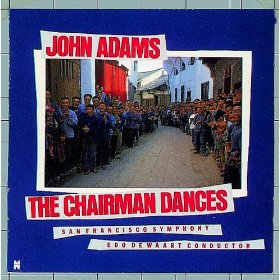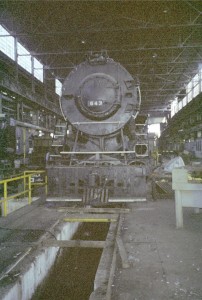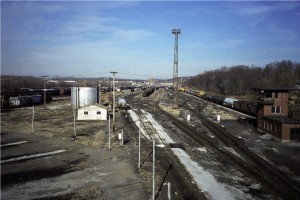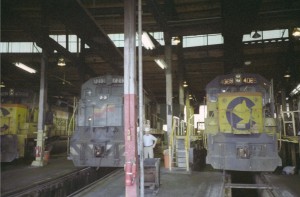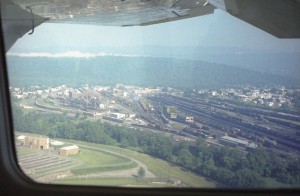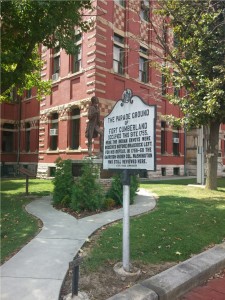Cumberland Days
Theme Songs Page | Previous Theme Song | Next Theme Song
Cumberland Days
The Chairman Dances, by John Adams, performed by the San Francisco Symphony, conducted by Edo De Waart (1987), encountered 1987-1989
Available on Spotify | Buy it here | See it here | Sheet music here
By the mid-Eighties, I had made sufficient progress as a junior lawyer that my place in my law firm seemed assured. What I’d assured, for as long as it lasted, was a work life primarily devoted to tending to one class of cases for one client. Clients are seldom forever, and case types go in waves, so my specialization was risky, but it was nonetheless a great way to start a career.
Particularly for a guy like me. As readers of these pages already know, I had a taste for the computer, an affinity for the library, a touch of wanderlust, and a meditative bent. And this was the job to suit all of these inclinations – as will become clear.
A Synergy of Abandonments
My client was CSX, the giant railroad company that was emerging at that era from the amalgamation of the Baltimore & Ohio, the Chesapeake & Ohio, the Seaboard, the Louisville & Nashville, and other roads. All of these railways, indeed all of American railroading, had been built on the steam locomotive. A generation before, though, steam power had been abandoned; now a large part of the railroads’ workforce was being abandoned as well. Really, really abandoned; there is a chart here that gives a sense of how thoroughly abandoned those old workers were. Some highlights: from 1947 to 1986, the four decades before I got involved in this work, U.S. railroad employment had plummeted from 1,516,000 to 323,000. By the time I got out of this work, in 1994, the total was down to 234,000.
But it’s an ill wind that blows no one any good. The synergy from those two abandonments nurtured my career for a while. Consider the steam locomotive: in essence a boiler laid on its side. And in the latter part of the industrial era, standard engineering practice called for doing one thing with pretty much any boiler: wrapping it in asbestos. Locomotive maintenance, in turn, called for these great beasts of machines to be lugged into back shops and roundhouses, stripped of their metal jackets, and for the asbestos sheathing to be pried away so that the machinists could get at the boilers’ innards. And then the process would be reversed. Needless to say, the unsheathing and resheathing would cause asbestos to become “airborne,” as industrial hygienists would term it.
By 1986, there were a lot of out-of-work old men with breathing difficulties who had once worked for the railroad. From their perspective the railroad had shown them no loyalty; now it would be their turn to show none. Along with tens of thousands of former smokestack industry workers around the country, they found lawyers and took their former employers to court for what had happened to their lungs. And among the defendants were the legal shells of CSX’s constituent railroads. When they were sued in Maryland, the cases came my way.
Now, at least in my view, at that time and still today, the claims of the plaintiffs in these cases to be suffering from asbestos disease were generally dubious, and the asbestos disease in those who were genuine asbestos victims was generally not very consequential.[1] But I never thought that occupational disease was what the cases were really about. I thought of them as a sort of collective evening of the score between employees and an employer which had turned them out. Whatever the truth of the matter, the cases had to be dealt with.
The railroad almost never got sued by itself. The manufacturers of the asbestos products previously used in the railroad industry (not just boiler lagging but brake pads and gaskets) always got sued along with the railroads – at least until the asbestos claims put those fellow-defendants into bankruptcy. And as much as the railroad would have liked to turn around and point the finger at this gradually shrinking pool of co-defendants or at the tobacco companies, it was also a fact that all these other companies were suppliers and shippers. So there was an odd combination of antagonistic and shared interests at work.
Catnip
It was all catnip to me.
First, there were a lot of plaintiffs, allowing me to organize a lot of data, to set up a database, in other words – doing this hands-on in an era when most lawyers, even the few who had direct access to a computer, wouldn’t have even known exactly what a database was. I, by contrast, was given a room just for documents and my very own computer. The software I relied on on that computer was truly primitive, something called Nutshell. About the time this work drew to a close, I started using true relational databases for other things, and it became clear in retrospect that in my asbestos years I had been trying to force a two-dimensional database (basically a big spreadsheet) to do things beyond its natural limitations. But I came close enough, largely because I was left alone and given plenty of time; any gaps that emerged I could bridge in ways that weren’t strictly database queries. I don’t know how much of my time was written off by the responsible partner – a lot, I suspect. But I was teaching myself database work, which has been a mainstay of my personal and professional life ever since.
There were lots of interesting legal questions, which I can’t discuss, but I can say that they gave me very good reason to spend afternoons looking at statutes and cases in the library, and drafting legal memos, the lawyerly occupation above all others that I enjoy.
Then too I was learning all about a medical field. I found out that all the expert witnesses referred to a body of medical literature comprising about three hundred articles. I painstakingly assembled those articles, read them all (indexing them in my database), and learned enough to be dangerous, as the saying goes. Armed with this jerry-built medical knowledge, I had to develop expert witnesses. With some help from lawyers who were defending railroads elsewhere, I had to go travel to various places where the experts were to make them ready to testify.
Old Shops, Old Warehouse
I also had to travel to the old locomotive shops, in places like Glenwood and Connellsville, Pennsylvania, and Cumberland, Maryland, to figure out what I could about the working conditions twenty to forty years earlier. (It was a sign of the times, I still remember, that at one of these shops, when the word got out I was a railroad lawyer, I was mobbed by workers asking when the next buyout would be.) While visiting these shops, I would take pictures which would tell me tantalizingly little, but which would at least fix these places in my memory somewhat.
Knowing the conditions also meant knowing the products involved. Gradually I built up a book of photos of the old products, especially photos with the name identifications of the manufacturers. I figured that even if the railroad was sensitive to the perils of implicating suppliers, I had to know who they were. This took me to old repositories of dusty records, all in the process of being trashed by a corporate colossus that could not have cared less about preserving relics of its past. Principal among the places I looked was the old Baltimore & Ohio warehouse at Camden Station in Baltimore.
Modern baseball fans know it as the backdrop to Oriole Park at Camden Yards; I knew it in its dying gasp as an actual warehouse. Many of its windows were broken; birds and bats flew in and crapped on cardboard boxes filled with every imaginable kind of railroad record, indexed in haphazard ways. You could get lost in that vast space, a kind of vertical equivalent of the repository where the Ark was stored at the end of Raiders of the Lost Ark. As indignant as I felt about this handling of the old records, veritable books about a bygone way of life if you knew how to read them; I knew that dumpsters and shredding awaited these boxes that I might be the last human ever to open.
But it wasn’t just dusty places I went to. I also had to sit in a high rise office tower to go through several years of corporate minutes of the B&O and the Western Maryland, to learn when and how locomotives had been purchased – and to rule out what lawyers call “notice” of asbestos claims – which of course no one had received. (Remember that asbestos had been rendered ubiquitous precisely to promote safety, not to destroy it. And that such benevolent purpose was the state of the art until about 1972.)
My Plaintiffs
Beyond that, I had to get to know my plaintiffs. I know, I know, my client was the defendant. But in order to try to defend that client, I still had to know the plaintiffs, these machinists and brakemen and engineers and firemen and maintenance-of-way workers, and I thought of them as mine. I had to get to know about their individual asbestos exposures, their individual careers, their medical histories, their hobbies, their tobacco use, their families, their non-railroad occupational exposures to asbestos. Sometimes they had moved far away, and I went after them and their treating physicians: to San Francisco, to DuBois, Pennsylvania,[2] to Sandusky, Ohio, to Three Churches, West Virginia.[3] But most of them had not followed that pattern.
No, most of these old men had aged in place, in or near the Appalachian railroad towns I’ve mentioned. This especially meant Cumberland, Maryland, the home of the big back shop that CSX still used (and in 2014 still uses under the name of the CSX Cumberland Diesel Locomotive Shops) to service much of its motive power fleet (all diesels now, of course). I and a group of lawyers representing the dwindling but still substantial corps of manufacturers of asbestos products once used by railroads would sit in a conference room for days on end, several times over the years I was doing this work, asking the same questions over and over again of one after another railroad worker. After a couple of stabs at other venues, we lawyers came to a consensus that the place to take the depositions was the Best Western Braddock Motor Inn in the little village of La Vale, halfway between Cumberland and Frostburg.
For me, it was a wonderful time, though it is a bit peculiar to describe.
Getting There
Let me start with the trip itself. Though once or twice I flew out to Cumberland (once in a private jet chartered by a defense lawyer who had far more clout and financial backing than I did), mostly I drove out on superhighways, as far as they would take me – which was not initially all the way. What is today known as I-68, the leg of the road between Hancock and Cumberland, La Vale, and Frostburg, was still being built when I started. I would roll out of bed before sunup, and after about two hours’ drive be in Hancock, the narrowest part of Maryland’s panhandle, about 1.8 miles in total squeezed between Pennsylvania and the Potomac. Then the trip became more of a challenge. The old National Highway, aka Route 40, uneasily coexisted with the superhighway under construction that oft-times was usurping its roadbed. At best, a driver could expect to cope with detours, mud, and dust from the great machines that were, foot by foot, grinding mountainside into freeway. At worst, there could be delays up there in the clouds on the curve of a two-lane highway with no sightline to what was halting traffic and no intelligence about when the cars would begin to roll once more. As the months and years went by, more and more was done, so that eventually you could get right up to the brow of the valley where Cumberland sat, plunge down the mountainside, and then zoom up the hill again toward the mountain pass where La Vale lay.
(It was while going through that dip in the opposite direction that my “single again” car, a sporty but truly disappointing Toyota Celica, finally died on me, when I found that I could not engage the clutch to go back uphill; this vehicular fail, along with my changing life circumstances, prompted me to buy my “newly remarried and looking forward to parenthood minivan,” a Plymouth Voyager, which is the car that mainly comes to mind now when I think of these trips.)
Relaxed
Eventually, you’d get to the Braddock, lying just north of the new highway, adjacent to an exit.
The setting was always calming after the rigors of the road. There was a babbling little mountain stream, the Braddock Run,[4] shaded by pleasant trees that ran right past the parking lot, and the building was covered with brown rustic-looking wooden shingles. You could park your bags in your room and then go right down to another hotel room that had had the beds taken out and a table brought in, and go to work.
The depositions themselves were about as relaxed as litigation ever gets. I many not have understood why at the beginning, but I soon understood why. Nothing really mattered. All these cases were going to be resolved. From the point of view of the corporations that sent most of the lawyers, these were exercises in putting checkmarks in the database. Did a man have pleural thickening? Did a man have a plausible claim to asbestos exposure? Those and similar questions were ultimately reduced to statistics on both sides. And periodically I would be told that a group of cases had been resolved, I presumed with some reference to those checkmarks, though I seldom learned much about it. Above my pay grade.
I never got to try one of these cases. Not one. But no one grudged me the opportunity to sit in a hotel room and make believe. It took me a while to figure out the game, but when I did, it certainly took the pressure off. I realized that, as Arlo Guthrie put it, “the judge wasn’t going to look at the twenty-seven eight-by-ten color glossy pictures” – all the articles and the databases, and the expert testimony I had so painstakingly assembled. It was all Kabuki.
Learning A Community
So even though I came to each deposition with a full collection of work records and medical records, even though I asked all the right questions and got into occasional tussles with the plaintiffs’ lawyers over objections, basically I was free to enjoy what the depositions had to offer: an unparalleled look at a bygone slice of life. I developed a genuine affection for the railroad men, and got to know a lot about them as a community: who was married to whose sister, who had worked alongside whom, whom they had reported to in the roundhouse at a particular era.
I learned about their hobbies (a lot of what they called “feeshin’” and a fair amount of roller skating). I learned that the industrial world that had produced them had collapsed. That there had been three big employers: the railroad (which had so drastically shrunk), “the Celanese” (acetate works, closed in 1983) and “the Kelly” (Kelly-Springfield tires, closed in 1987). The rug had been pulled out from under them and their friends, and their dependence on tobacco had in many cases destroyed their bodies and condemned them to invalid lives and early deaths. These were men who by-and-large had been built for loyalty, for relationships of lifelong reciprocal support between themselves and their country and their employers. And even when it all went wrong, most of them went on being the strong people they had grown up to be, survivors of the Greatest Generation, mainstays of families.
Of course they were not being honest about asbestos disease; I daresay most of them knew that. But I’m sure they viewed the litigation as a way of getting a little bit of their own back against an employer which, if it didn’t exactly inflict asbestosis on them, had still completely let them down. I did my duty by my client, but I was glad it was so ineffectual.
Always A Pleasure
As for me, the stays at the Braddock were frequent, for one days, two days, once even a week. There wasn’t much in the way of nightlife or fancy dining (one first-class restaurant in Frostburg), but you could go for a dip in the hotel pool, and just luxuriate in the peacefulness of the setting. And no one ever questioned my expenditures. To the extent I desired company, I generally had it, in the other lawyers participating, on both sides. I made friends with more than one of the plaintiffs’ lawyers we sat across from during the day.
So it was almost always with pleasure that I would rise early in the morning from time to time and chuck boxes of documents into my minivan, and head around the Beltway to the beginning of I-70. I used to joke that the car knew the way. Even today, over twenty years later, if I approach that interchange in an absent-minded state, my tendency will be to move my vehicle into that exit lane without thinking about it, forcing me to correct my course when I wake up and realize what I’m doing.
Foxtrot? Really?
While I was on those trips, the cassette in my onboard cassette player was often the San Francisco Symphony’s very popular rendition of five works by composer John Adams, highlighted by his twelve-and-a-half-minute fantasia The Chairman Dances. The liner notes were cunningly worded to make it seem, without actually saying it, that this number was from Adams’ hit opera Nixon in China. Although (as my readers know) I’m a great fan of the musical stage, I’m not much of an opera guy, and so I went on believing what the liner notes kind of implied until I was in preparation to write this piece. When I acquired a Blu-Ray of the Metropolitan Opera production, I realized I’d been had. The correct way to describe the relationship between the opera and this piece is that Chairman makes liberal use of musical figures and themes from the third act of Nixon. It is simply a marvelous polyrhythmic confection. The subtitle is “Foxtrot for Orchestra,” but when you’re talking about a minimalist composer, don’t look for promises like “foxtrot” to be kept. Foxtrots are four-beat animals; this sounds as if it’s written in eight much of the time,[5] though there certainly is a quite-deliberate Fred-and-Ginger feel about a lot of it; it’s supposed to evoke Mao, rejuvenated in fantasy, dancing with his “fiendlike queen” Jiang Ching.[6]
Everyone who hears this piece seems to hear different things in it, many of them surprising to me.[7] But that capacity to evoke almost anything is a strength. The piece soars at times; it sounds like pounding industrial pistons at others; it whispers like the second movement of Eine Kleine Nachtmusik at others. It covers a prodigious amount of exciting musical territory in less than a quarter hour. The multitude of the “reads” is easy to understand.
A Happy Association
My own is what you’d expect: a vision of the territory between the Baltimore Beltway and Maryland’s Alleghanies rushing up to meet my windshield. This infinitely pliable music has a motile quality most of the time that goes well with memories of the rapidly changing scenery. The cassette bearing Chairman Dances and its four companion-pieces was given me by a paralegal who made the ride out to Western Maryland with me once, and perhaps made the present on that very trip. This poor woman was cursed with an eye-rollingly bawdy name that would not have been out of place in an Ian Fleming novel, and it was a terrible fit for her. She was (at least in the stage of her life she’d reached by the time I met her) one of the most straitlaced Christian fundamentalists I knew. She was fundamentally averse to the temptations of the flesh, and I think even to the extent such temptations extended to the voluptuousness of the ear (a susceptibility of mine, to be sure), she was uncomfortable with them. Certainly the cassette was of no interest to her. So she was glad to give it away, and I was glad to receive it.
Generally, all five pieces on the tape would last me most of the way to Frederick if I played it once, or to Hancock if I played it twice.
To this day, if I hear the music, I think of my Cumberland days, and if I take that drive, I think of the music. They were good trips for me, and it’s a happy association.
___________________
[1]. Based on the medical science as I absorbed it, I knew the following. Asbestos can cause four primary conditions: a) asbestosis, b) thickening of the pleura (the coating of the lungs), c) lung cancer, and d) mesothelioma. Asbestosis is an actual disease caused by asbestos exposure that makes it hard or impossible to breathe; but you seldom get asbestosis from the levels of exposure that existed in railroad shops. Moreover, smoking-related chronic obstructive pulmonary disease (and they all smoked) can mimic the symptoms of asbestosis. Pleural thickening, though strongly associated with asbestos exposure, is not a disease and has no symptoms, but it does show up on x-ray, which afforded the plaintiffs’ experts a dubious hook on which to hang the claim that asbestos exposure had caused the obstructive disease many of the plaintiffs suffered from. Lung cancer, by contrast, is, as we all know, a deadly disease, but it is weakly associated with asbestos – while strongly associated with tobacco use. And though mesothelioma is deadly, and strongly associated with asbestos, and can arise as a result of minor exposures to asbestos, almost none of the plaintiffs I was up against, perhaps two among dozens, had been diagnosed with it.
[2] I flew to DuBois in a tiny prop craft in the middle of a thunderstorm, in what was probably the scariest flight of my life.
[3] I had to go to Three Churches three days after my wedding described in the previous piece. There was no way to finesse things to schedule a real honeymoon. Instead Mary and I spent the night of our wedding at home, drove to New York the next day, had one night overlooking Central Park, then drove back (albeit by a pleasantly circuitous route), and early, early the following morning, I had to get up extra early and start driving to West Virginia. I was told You’ll know you’re in Three Churches when you see three churches. So in 48 hours I went from Central Park South to a small, dirty trailer in the Appalachians where there was no room to sit, while we listened to a dying old man on oxygen tell his life story.
[4].
It’s a safe assumption that everything around Cumberland named Braddock has as its namesake General Edward Braddock, a British officer who commanded Fort Cumberland, approximately where the Allegany County Courthouse now stands, and who fell in the French and Indian War. (Washington served as Braddock’s aide on that campaign.)
[5]. The score starts in two, and there are parts in four and in three. Maybe that’s how it’s written. I still say it’s really in eight most of the time, although I note that the polyrhythms sometimes resolve by incorporating a two-beat rhythm and a four-beat one by amalgamating them as two four-beat structures.
[6]. The score is prefaced:
Chiang Ch’ing, aka Madame Mao, has gatecrashed the Presidential banquet. She is seen standing first where she is most in the way of the waiters. After a few minutes, she brings out a box of paper lanterns and hangs them around the hall, then strips down to a cheongsam, skin-tight from neck to ankle, and slit up to the hip. She signals the orchestra to play and beings to dance by herself. Mao is becoming excited. He steps down from his portrait on the wall and they begin to foxtrot together. They are back in Yenan, the night is warm, they are dancing to the gramophone…
Confusingly this is signed “Scenario by Peter Sellars [the impressario and director] and Alice Goodman [the librettist],” yet Chairman was not performed as part of Sellars’ opera nor sung. Whatever the meaning of this, although the opera, and I believe Chairman Dances as well, do not blink at depicting Jiang Ching as savage, the place these works go with two of the most murderous personalities in history, Jiang Ching and Mao, is largely into the private parts of their psyches to which their public malevolence is not perhaps as relevant. In “going there,” Adams and his librettist, Alice Goodman are clearly unapologetic. These works are only in part, perhaps lesser part, about the historical impact of these characters, or those of Mr. and Mrs. Nixon, Chou En Lai, and Henry Kissinger, the other principal roles. Indeed, one way to describe the whole opera is an exploration of the private subconscious lives of people whose public lives were elevated to near- or absolute cult-of-personality status.
[7]. See the reader comments on one YouTube transcription of the San Francisco Symphony recording.
Copyright (c) Jack L. B. Gohn, except for album art and Camden Yards photograph. Source of Camden Yards photograph: http://www.realclearsports.com/lists/mlb_stadium_landmarks/warehouse.html?state=stop.
